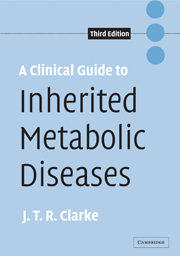Book contents
- Frontmatter
- Contents
- Reviews of first edition
- Reviews of second edition
- List of tables
- List of figures
- Preface
- 1 General principles
- 2 Neurologic syndrome
- 3 Metabolic acidosis
- 4 Hepatic syndrome
- 5 Cardiac syndromes
- 6 Storage syndrome and dysmorphism
- 7 Acute metabolic illness in the newborn
- 8 Newborn screening
- 9 Laboratory investigation
- 10 Treatment
- Index
- References
3 - Metabolic acidosis
Published online by Cambridge University Press: 10 September 2009
- Frontmatter
- Contents
- Reviews of first edition
- Reviews of second edition
- List of tables
- List of figures
- Preface
- 1 General principles
- 2 Neurologic syndrome
- 3 Metabolic acidosis
- 4 Hepatic syndrome
- 5 Cardiac syndromes
- 6 Storage syndrome and dysmorphism
- 7 Acute metabolic illness in the newborn
- 8 Newborn screening
- 9 Laboratory investigation
- 10 Treatment
- Index
- References
Summary
Metabolic acidosis is a common presenting or coincident feature of many inherited metabolic diseases. In some cases, the acidosis is persistent, though so mild that the generally recognized clinical signs, such as tachypnea, are absent or so subtle that they are missed. In other cases, the patient presents with an episode of acute, severe, even life-threatening, acidosis, and the underlying persistence of the condition is only recognized after resolution of the acute episode. Diagnostically, the most frustrating presentation is infrequent bouts of recurrent, acute acidosis separated by long intervals of apparent good health during which diagnostic tests show no significant abnormality. This is a particularly challenging situation.
Buffers, ventilation, and the kidney
The hydrogen ion concentration, [H+], of body fluids is maintained within very narrow limits by a combination of buffers, acting immediately, pulmonary ventilation to restore the capacity of blood buffers, and renal mechanisms to eliminate excess H+.
Quantitatively, the most important buffers in blood are the proteins, both the plasma proteins and hemoglobin. Alterations in the concentrations of these proteins, particularly hemoglobin, may seriously compromise the capacity of the body to cope with sudden accumulation of acid. The buffering contributed by the equilibrium between HCO3− and H2CO3 is important because the capacity of the system is rapidly restored by elimination of H2CO3 through conversion to CO2 and expulsion of the excess CO2 by increased pulmonary ventilation.
- Type
- Chapter
- Information
- A Clinical Guide to Inherited Metabolic Diseases , pp. 90 - 115Publisher: Cambridge University PressPrint publication year: 2005



